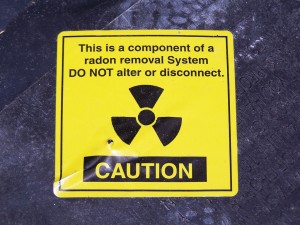 The deadly odorless, tasteless, and invisible gas radon can be a problem anywhere. The geographical location of a structure, type or age matters little. Since radon is a naturally occuring radioactive decay product of Uranium and other elements – which are commonly found in soul – it can pose a threat to anyone.
The deadly odorless, tasteless, and invisible gas radon can be a problem anywhere. The geographical location of a structure, type or age matters little. Since radon is a naturally occuring radioactive decay product of Uranium and other elements – which are commonly found in soul – it can pose a threat to anyone.
It seeps into residences, businesses and structures through cracks in the foundation, walls or flooring. Once inside, it collects in great amounts subjecting the residents within to prolonged exposure.
The biggest problem with the invisible gas radon, is that there are no short term symptoms and the health effects are caused after long term exposure. It is the second leading cause of lung cancer in many countries, responsible for the deaths of more than 21,000 Americans every year. Lung cancer has an extremely high mortality rate because symptoms don’t generally show until the disease has progressed beyond a curable state. In that respect, prolonged exposure to radon can be extremely deadly.
The Invisible Gas Radon Poses a Threat to Servicemembers Living on Base in Japan
A report from the Department of Defense Instructor General expressly discusses the discovery of mold and radon gas problems in Japan’s military housing – specifically in Yokosuka naval base. The 2014 Military Housing Inspections report, states that mold and improper radon gas detection measures are posing “serious health hazards” to servicemembers living on base. Furthermore, the Inspector General found 1,057 code violations.
The unfortunate part is that this seems to be not just a problem in Japan, but a more widespread problem in military housing across the globe.
“Based on our inspection, the significant presence of mold and DOD’s current ad hoc approach to radon mitigation places unnecessary risk on the warfighter and their dependents.”
At Yokosuka, two buildings were found to contain elevated levels of the invisible radon gas at nearly six times that of the recommended level set by the U.S. EPA. In addition, a building at the Marine Corps Air Station Futenma, Camp Courtney and Kadena Air Base was found to contain elevated levels. Also, a building at Naval Air Facility Atsugi which was found to have levels four times the recommended limit, although a second test showed levels below the limit. This shows a great example of why you should conduct multiple tests of a residence, to acquire more accurate readings.
We Need to Take Action Against the Invisible Gas Radon
The best thing we can do is pass on information about the deadly gas and encourage our families, friends, colleagues and acquaintances to test their own residence. Take action against the virtually indetectable gas and conduct a test in your own home. Better to take action now before health issues arise in your immediate family. At the least, the information above should prove that radon can exist anywhere – even in foreign military housing.
Via: Military.com


